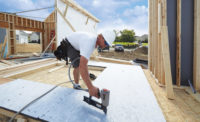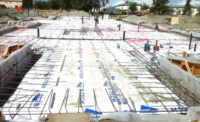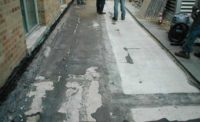Saving on Labor and Material Costs for Roof Insulation






An increase in labor costs, coupled with a shortage of workers, continues to deliver a double wallop to professional roofers’ bottom lines. To overcome these problems and help boost profits, savvy roofers are employing product solutions that reduce roof insulation labor and material costs, while still providing a well-insulated roof assembly.
Rising labor costs are no small problem—77 percent of commercial roofing contractors reported labor cost increases in 2015, according to Roofing Contractor magazine’s “State of the Industry Report and Survey 2016.” The average increase was 11 percent (nearly 8 times higher than the 2015 U.S. inflation rate).
Measuring the Costs vs. Benefit of Roof Insulation Types
Because roofing professionals have numerous options for insulation, it is important to use a relevant metric for comparing costs vs. benefits. A common number consulted is R-value per inch of thickness. On the surface, this seems like a valid measure for minimizing your insulation material costs. While this might be useful if you’re trying to build the thinnest roof assembly, it says nothing about cost.
To determine which insulation provides the highest benefit vs. cost, more roofers are considering the R-value per dollar spent on both materials and labor. In other words, which insulation provides the best bang for your buck?
Following is a comparison of how the three types of rigid foam insulation rate on R-value per dollar and R-value per inch of thickness:
*Because insulation material and labor costs vary by region, specific R-value per dollar figures change frequently, but EPS consistently rates highest when compared to other rigid foam insulations.
The difference in R-value per dollar between EPS and Iso is even more pronounced as of the 2015 updates to the NRCA Roofing Manual: Membrane Roof Systems. NRCA lowered its in-service R-value recommendations for Iso to 5.0 per inch, in light of testing that showed lower R-values than Iso manufacturers’ published long-term thermal resistance (LTTR) values.
Practical Solutions for Reducing Insulation Costs
For roofing professionals who choose EPS insulation for its highest R-value per dollar among rigid foams, the material provides additional ways to reduce material and labor costs.
Following are four examples of ways various EPS insulation products can help save tens of thousands of dollars, or more, depending on your project’s size.
Recovers of metal roofs
Roofing Contractor magazine’s “State of the Industry Report and Survey 2016” found that 70 percent of metal roofing jobs involved standing seams. Both architectural and structural standing seams make it challenging to create a flat, stable surface during roof recovers. A simple way to insulate the roof and provide an even surface for other parts of the roof assembly, is to install “flute fill” insulation. Such products fit between the spaces of the metal roof’s flanges, so lay into place easily.
An advantages of EPS flute fill over other insulations is that it can be custom-cut to fit any metal roof flange profile, and comes in a range of compressive strengths suitable for nearly any roofing application. EPS flute fill can save up to 25 percent in costs compared to similar Iso products.
Build-up of sloped roofs
Converting a flat roof to a sloped roof usually requires that roofers stack multiple layers of insulation. This is a labor-intensive process with XPS and Iso, as crews must haul and place numerous rigid foam sheets of only a few inches of thickness. By comparison, EPS insulation is available in blocks up to 40 inches thick. As manufacturers can cut those to virtually any slope and any shape to fit roof crickets, saddles, valleys and ridges, tapered EPS speeds insulation installation, and can reduce roof insulation costs up to 30 percent compared to other tapered insulations.
Green roofs
For planted roofs that include landscape contours, roofers face the challenge of not adding excess weight, and defending against moisture intrusion. An effective solution is provided by EPS geofoam. Successfully used in civil engineering and building projects for decades, the material is an ultra-lightweight engineered fill that can be used to create contoured landscape features such as hills and valleys. EPS geofoam weighs from 1 to 3 lbs/cu ft., depending on the product type specified, compared to 110 to 120 lbs/cu ft. for soil.
And, as EPS geofoam dries quickly and has minimal long-term moisture retention, it helps defend green roofs from moisture intrusion.
High-traffic roofs
For roofs that need additional strength to withstand foot traffic and severe weather, an ideal option is composite insulation. One product incorporates EPS as a lightweight, insulating and resilient insulation, while an Iso layer serves as a durable, insulating cover board. Some composite products of this type carry a UL Class A fire rating for both combustible and non-combustible decks, and are compatible with a range of roofing membranes—including EPDM, TPO, PVC, CSPE, and low-sloped, built-up and modified bitumen membrane systems.
Choosing an Insulation Supplier
Dozens of manufacturers throughout North America produce EPS, XPS and Iso insulations. When choosing a supplier, to further help streamline and enhance the installation process—and reduce costs—traits to consider include:
- Code compliance: Does the manufacturer have code acceptance reports for its products, including testing to industry standards?
- Technical support: What support services does the manufacturer offer that can reduce roofing contractor costs? Examples include design expertise, material take-offs, consultation on product substitutions, and in-field support.
- Customized products: Can the manufacturer supply custom-cut insulation components to help reduce field labor?
Looking for a reprint of this article?
From high-res PDFs to custom plaques, order your copy today!








